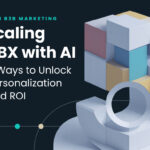
SiriusDecisions: The New Demand Unit Waterfall
Consider this a B2B marketing nerd alert. We’re about to talk – excitedly, I might add – about funnels, revenue stages, buyer groups, engagement, conversion rates, and a whole bunch of other things that will be an indecipherable snooze-fest to anyone other than dyed-in-the-wool B2B revenue nerds. You’ve been warned.
==================
You may have heard that SiriusDecisions just launched a new waterfall model.
This is a big deal! But why?
Why funnel models matter
The funnel model — more than any other concept in the world of B2B revenue growth — is one of the most referenced, most used, and most simple tools for bringing some amount of clarity, order, and focus to an ever-more-complex world of modern marketing and sales.
Smart organizations use their funnel framework for some very important things:
- To measure and report the performance of their revenue program and related tactics
- To map, analyze, and improve their lead management processes
- To validate and support more accurate revenue forecasts in the near term
- To analyze and guide investments they need to consider for their achieving longer-term revenue goals
(By the way, some might say the funnel model is also one of the most misunderstood, most misleading, and most abused within B2B. In fact, there has been a fair amount of funnel-hating going on over the past several years. But the funnel is still the best metaphor I’ve found for quickly mapping people, process and technology to the revenue process. The trick is to know the limitations and avoid the potential dangers.)
SiriusDecisions Summit
Lots of thought leaders throw their hat in the ring when it comes to revenue frameworks and funnel models. But in the realm of B2B, no model has been more adopted or used than SiriusDecisions. Sirius is, in my book, the undisputed, heavyweight champion of B2B funnel models and supporting frameworks. So, it was with great anticipation that I watched Terry Flaherty and Kerry Cunningham, both Senior Research Directors with SiriusDecisions, step on stage at the SiriusDecisions Summit in front of 3,000+ marketers and unveil their new funnel model, The Demand Unit Waterfall.
For those of you who weren’t there, hopefully this blog captures the high points of what they shared — with a dose of my perspective thrown in as well.
A quick trip down funnel memory lane…
The Demand Unit Waterfall is actually the third iteration from Sirius. It’s useful to back up and talk about each one because it gives important context to the underlying complexity of the new model. Seeing the way the waterfall has evolved also makes an important point for business people: things change. And when they do, you have to update your approach. Even if — especially if — it feels like a sacred cow.
2006 — The First SiriusDecisions Waterfall

It’s hard to believe this old chestnut was released back in 2006. It established the fundamental revenue stages that you hear every day… Inquiry, MQL, SAL, SQL.
Those were the days.
This model was incredibly important because it helped to establish a framework against which marketers could begin to measure the impact and effectiveness of their activities, spend, campaigns. It also highlighted the importance of handoffs in the lead management process. It laid the groundwork for the importance of sales and marketing alignment. It also established MQL (and eventually SAL) as the key indicator of “Marketing doing its job” (perhaps to a fault, as we would begin to realize about 8 or so years later).
This first waterfall was a watershed. But things changed. What drove the need for Sirius to develop an evolved waterfall model?
- The rise of marketing automation
- The rise of inbound marketing
- The rise of tele (for inbound qualification, outbound prospecting, and sales development)
- The recognition of the importance of sales-generated demand
2012 — The Rearchitected Waterfall
Released in 2012, Sirius’ Rearchitected Waterfall was a major step forward in both nuance and complexity. It was a reaction and recognition of the four things listed above that evolved and emerged since 2006.
The Rearchitected Waterfall has been used (and I predict still will be used) to focus marketers on critical areas within the revenue process that deserve detailed analysis and improvements. It sheds a light down into the specifics of how, where and by whom leads and opportunities are sourced qualified, worked and closed.
From my perspective, most B2B organizations are still working to operationalize and perfect the way they apply and use this framework. Its level of detail can be a bit overwhelming to marketing and sales teams that are earlier in their maturity journey. That said, there is MUCH value to be unlocked by learning and applying this framework.
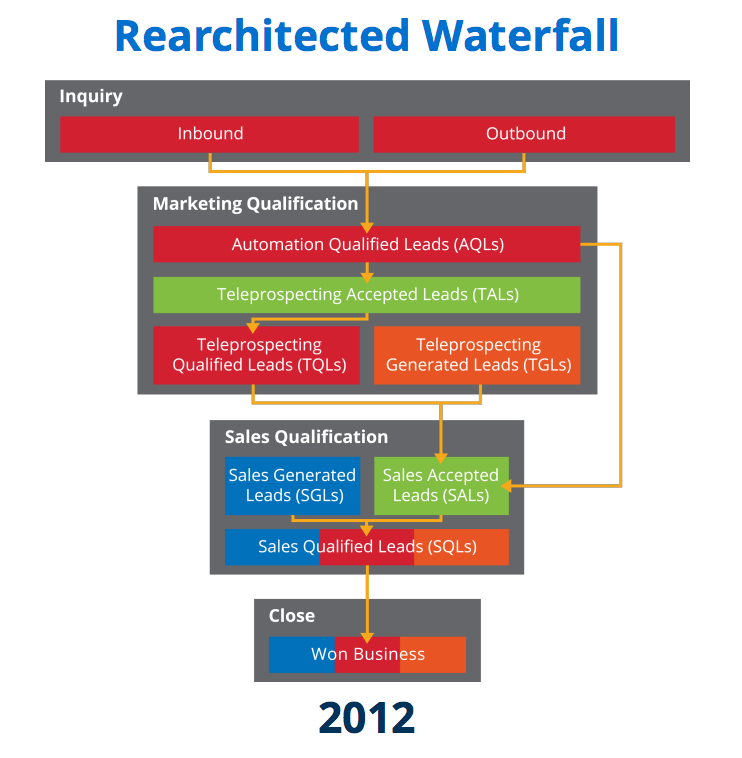
But things changed again. What drove the need for Sirius to develop another evolved waterfall model?
- The recognition that a LOT happens before an inquiry opts in to your program
- The increased focus on buyer needs as a key element with successful go-to-market strategies
- The rise of predictive analytics and intent monitoring
- The tendency to reduce marketing’s value down to “MQL quality and quantity” can lead to a distorted view of marketing’s true impact and influence on revenue
- The rise of account-centric approaches (i.e. Account-Based Marketing / Sales Development / Everything)
2017 — Enter The Demand Unit Waterfall
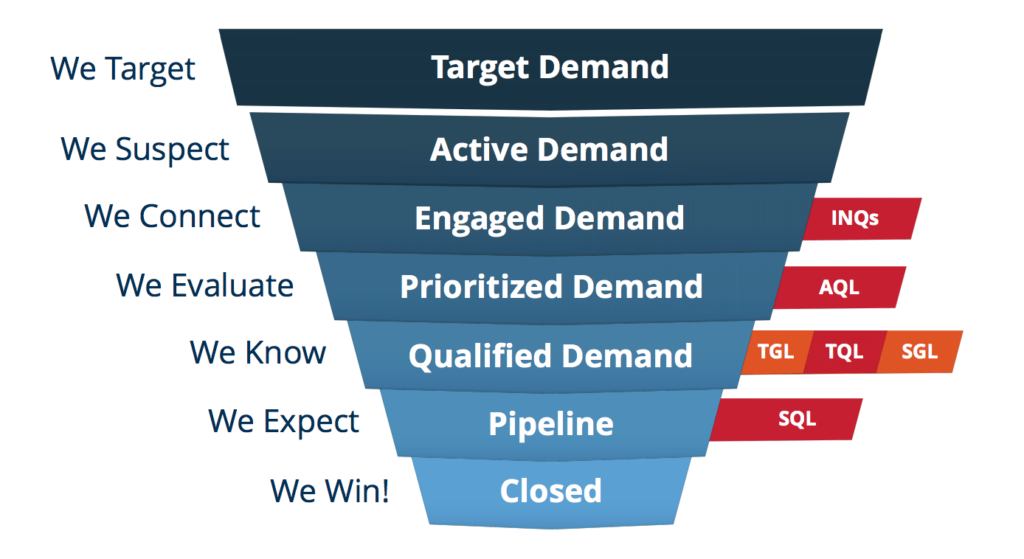
Voila! Behold the Demand Unit Waterfall. It might strike you as familiar to the point of being even a little underwhelming at first, but it actually contains some pretty deep and very relevant thinking. So let’s dig in…
Wait, what’s a Demand Unit?
A demand unit is Sirius’ term for a group of individuals within an organization who are trying to solve or should be solving a problem that’s a fit for one of your products or solutions. Think of it as a more rigorous and actionable definition of a “buying center” or “buying team.”This demand unit concept is important because it’s a strong recognition that focusing on leads alone doesn’t cut it any more with B2B, if it ever did. Why? Because within B2B marketing and sales, a single person rarely, if ever, actually buys anything. (Insert ABM huzzah here.) But on the other end of the continuum, marketing to an account doesn’t really work either. Why? Because an account is too broad, diverse and undefined a group to market and sell too. It’s not targeted enough. The demand unit serves as the right degree of granularity for targeting, marketing, selling and reporting demand within B2B. And yes, there are often multiple demand units within a given account.
Some key elements you’ll need to fully grow the Demand Unit Waterfall
- A more rigorous definition of the B2B Buyer
- Recognizing that there are several types of B2B Buyer needs
- Defining the Demand Unit
- Know what a Demand Map is
- The stages of the Demand Unit Waterfall
Who is the buyer in B2B?
In B2B, the answer to “What do you mean by Buyer” is multi-layered. According to Sirius, there are 5 layers to a B2B buyer:
- Market* — a group of accounts that share a common set of traits or needs
- Account — an organization (think of it as a “logo”)
- Buying Center — a line of business, a function, a geo-defined region
- Buying Group — a group of personas or roles who are connected by related requirements, needs and resources
- Persona — an individual who influences or makes B2B buying decisions by playing a role on a buying team(NOTE: #3 and #4 above often get combined in the real world.)
This is important because it reminds us that there is analysis and work to be done at every level of the “Buyer”. By making a more direct and explicit connection between individual humans, and the buying teams, accounts and markets in which they participate, you establish crucial foundation for eliminating the gross inefficiency of persona-only, volume-based demand creation.
* I think it helps to break down the big bucket concept of a “Market” into Total Addressable Market (TAM), Ideal Client Profile (ICP) and then Target Account List (TAL) with account tiers.
B2B Buyer Needs
We know that audience-centric go-to-market strategies outperform product-centric go-to-market strategies. But how do you become more audience-centric? A great place to start (and stay) is to become an expert in their needs of your target audience, and map them to your value proposition, solutions, and products. And in B2B, your target audience’s needs exist at multiple levels. SiriusDecisions recommends analyzing and mapping buyer needs at 1) the Organizational level, 2) the Functional level, and 3) the Individual level.
At Intelligent Demand we further break down individual needs into needs tied to that person’s role or job, and need tied to that person as a human who is in a real world situation. We do this as a way to uncover the underlying emotional drivers that are always at play — yes, even in B2B! (Actually, especially in B2B. Look up the research Google and CEB did about the power of combining rational and emotional appeals in B2B. It’s fascinating, and a great reminder of how important it is to remember the human in B2B.)
Okay, Say it again — What is a Demand Unit?
Remember from up above: A demand unit is Sirius’ term for a group of individuals within an organization who are trying to solve or should be solving a problem that’s a fit for one of your products or solutions. Think of it as a more rigorous and actionable definition of the “the buying committee” or “buying team.”
Said more technically: a demand unit is a buying group that 1) has active or latent needs that are a fit for one of your offerings, and 2) has an urgency or should have an urgency for solving that need.
As with many things from Sirius, this is right on. But I also predict this is going to be a little difficult to operationalize. That’s one of the biggest TBDs in my opinion. We’ll get there, but not without some learning, some technology and some time.
The Demand Map
One way to better understand and identify demand units within an account is through the concept of a demand map. This is Sirius’ framework for understanding and analyzing demand units. Or put differently: for mapping the real world connection between 1) an account, 2) individual personas, 3) needs, 4) the products and solutions that we’re trying to marketing and sell.
Check it out — and think about your own organization. Which best describes your marketing and sales use case?
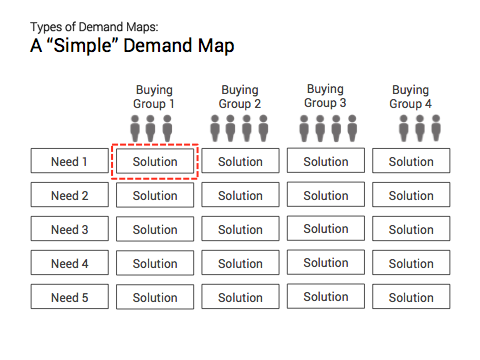
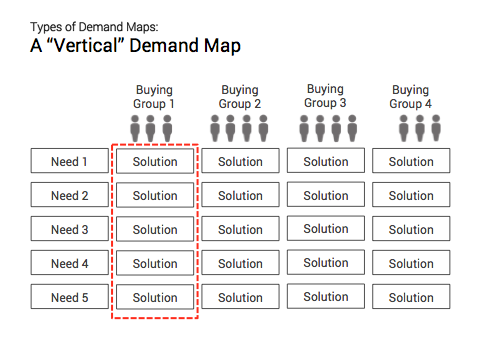
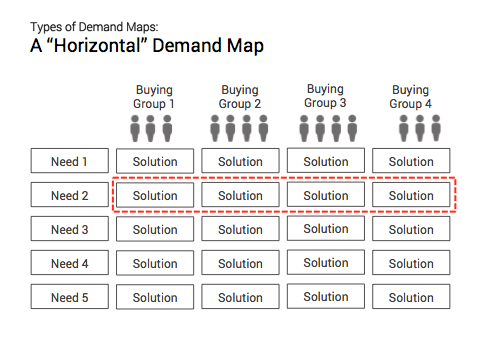
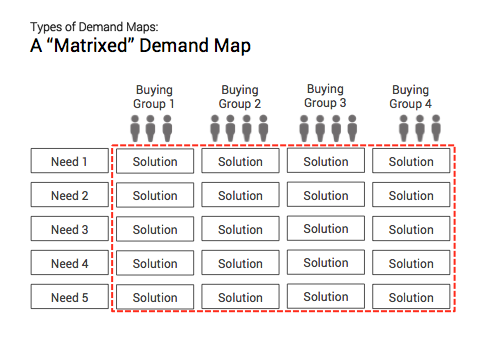
The Demand Unit Waterfall
With all of the above as context, we have the building blocks for understanding the stages of the new Demand Unit Waterfall. The top two stages are new for SiriusDecisions. The other stages map to prior Sirius waterfall models:
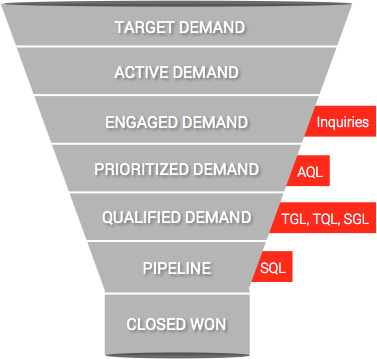
- Target Demand – this stage defines the size of your target market in terms of the number of potential demand units (Note: This is a new stage.)
- Active Demand Stage – this stage measures the number of demand units that are either in market or need to be in market (Note: This is a new stage.)
- Engaged Demand Stage – this measures a demand unit who has engaged with your marketing, tele or sales. (Note: This is analogous to the Inquiry stage.)
- Prioritized Demand Stage – the engagement of the demand unit has reached a scoring threshold that justifies additional tele or sales interactions (Note: This is analogous to the AQL stage.)
- Qualified Demand Stage – individuals within the demand unit have confirmed their fit, urgency, potential budget and willingness to engage with sales (Note: This is analogous to the TGL, TQL and SGL stages.)
- Pipeline Opportunity Stage – Sales has created an opportunity with a dollar value and a close date (Note: This is analogous to the SQL stages.)
- Closed Opportunity Stage – Revenue!
Separating Stages from Stakeholders is a GOOD THING
One of the things I really like about this new waterfall model is that it separates what we call “Revenue Stakeholders” from revenue stages. Doing this is very smart in my opinion because it helps poke a hole in some thinking that has frankly hurt alignment within B2B. Namely, that “marketing owns the top of the funnel, and sales owns the bottom of the funnel.” That’s always been false, and everyone knew it, but the funnel almost made us “grab territory.”
No more. By separating stages from stakeholder, we open our minds to different “revenue scenarios” or “revenue plays” for different go-to-market use cases. SiriusDecisions alluded to this during their presentation of the Demand Unit Waterfall. They showed it sort of like this:
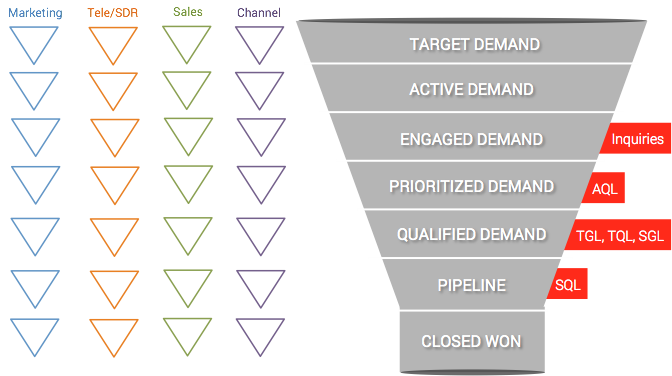
Once you see it clearly like this, it allows you to map out various revenue scenarios.” These scenarios speak to how and where collaboration and alignment must happen for revenue to grow. It is also a guide for where investments must be made.
Here are four B2B revenue scenarios that we see a lot at Intelligent Demand:
- Demand Generation – Direct
- Demand Generation – Mix of direct and channel
- Account-Based Marketing and Sales
- Pure eCommerce
(Single-headed arrows represent handoffs. Double-head arrows represent tight collaboration.)
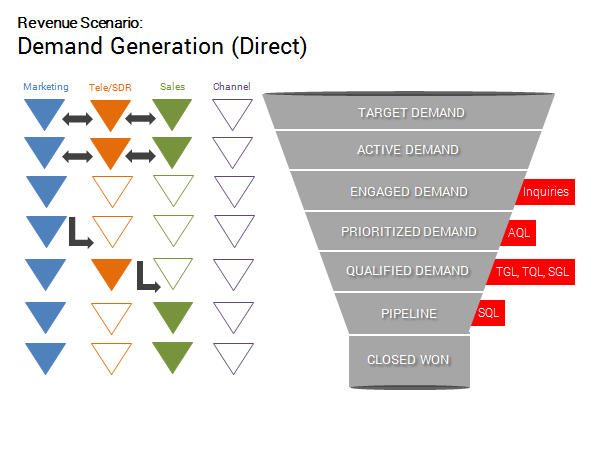
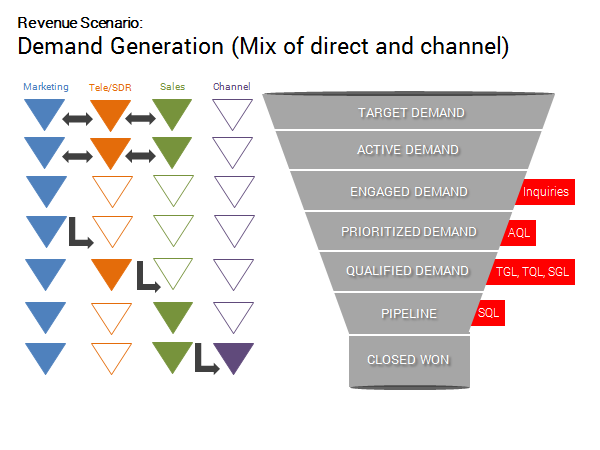
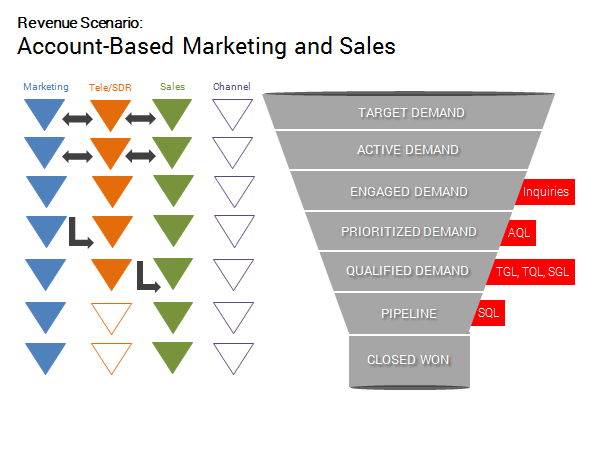
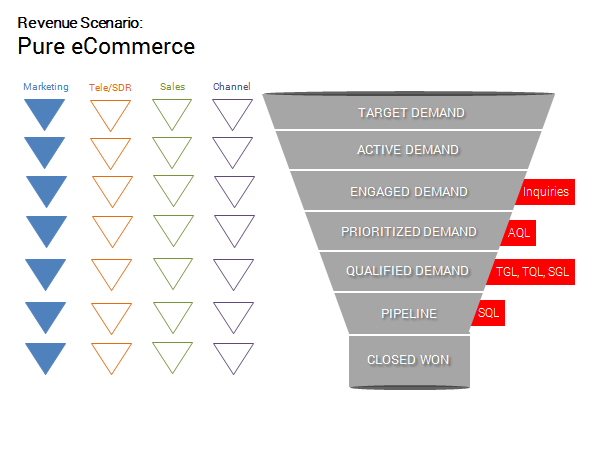
Eight thoughts about the Demand Unit Waterfall
Wow. That was a lot of information! Where does all of this leave us? I’ll try and summarize:
- I like SiriusDecisions’ Demand Unit Waterfall a lot.
- It’s actually not that new. It feels like a return to a more holistic and strategic understanding of how B2B revenue actually happens, but with a more modern, updated point of view that recognizes many advancements that are rippling through our field.
- It recognizes that a lot of important things happen before someone engages with you. This model starts all the way up at the target market level and moves through closed won (rather than starting at “Inquiry” as the older funnel models did).
- It recognizes and encourages account-based approaches — i.e. it isn’t myopically “lead focused”. (This is rather important for B2B!)
- We absolutely still market and sell to individuals, but now, we map and track them to their relevant demand unit for a much more complete picture. The good news is that the re-architected waterfall still applies. You can map its stages and terms (AQLs, TGLs, SALs, etc) to the stages of the Demand Unit Waterfall.
- It recognizes that engagement is a critical step toward qualification. In other words, the journey from Inquiry to Marketing Qualified (Account, Lead) to Pipeline and Closed Won (only) goes through engagement.
- It separates stages from stakeholders — i.e. Marketing doesn’t “own” the top and upper middle of the funnel, Tele/Sales development doesn’t “own” the lower middle of the funnel. And Sales and Channel Partners don’t “own” the bottom of the funnel. Yay for this!
- This model is deep stuff that speaks to much greater complexity that lies underneath. As such, it has a lot of implications that we all will need to peel back in the coming months. Specifically, how does the new Demand Unit Waterfall impact:
- How we measure and report the performance of our revenue programs and related tactics
- The technology and data tools needed to effectively operationalize market analysis, targeting, intent, lead versus account, and demand units
- How we map, analyze and improve our lead management processes
- How we create accurate revenue forecasts in the near term
- How we analyze and guide investments needed to achieve longer-term revenue goals
Hats off to SiriusDecisions for the great work! Let’s keep growing revenue!
If you and your team are looking to operationalize or just improve the way you leverage the waterfall in your organization, reach out. We can help!
Read more from Intelligent Demand and revenue leaders in B2B:
- 6 Smart Strategies to Make Creative Work Harder for Lead Gen
- How to A/B Test Ads, Landing Pages, and Emails the Right Way
- Comparing Smart AI Application Across B2B Campaign Strategies
- Spot the Red Flags: When to Transform Your B2B Marketing Organization
- The Intersection of AI and RevOps: Data Infrastructure, Cross-Functional Alignment, & Tech
